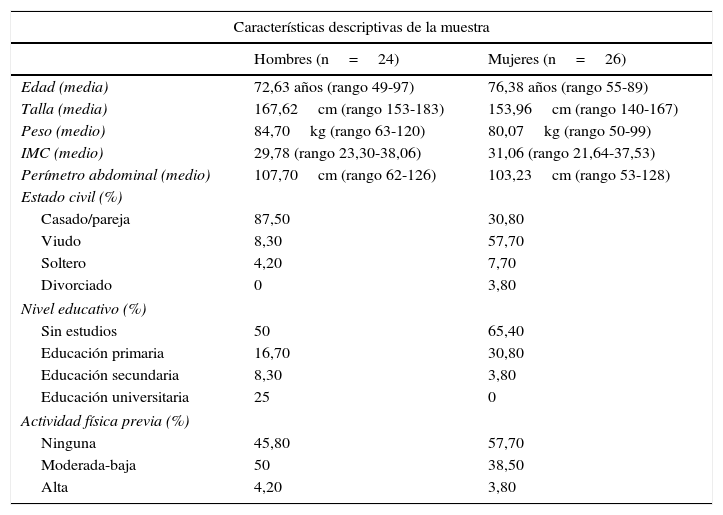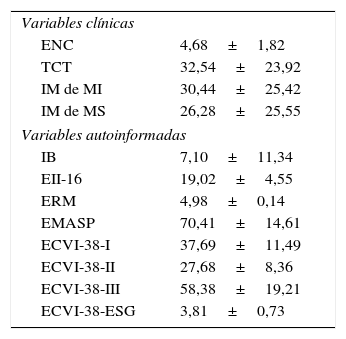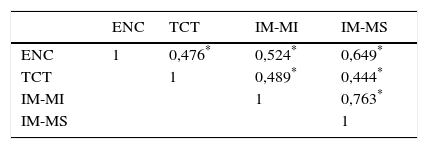La creciente demanda de tratamiento fisioterápico del ictus agudo requiere una predicción pronóstica temprana que facilite su gestión. Objetivos: 1) evaluar cómo se asocian las variables clínicas y autoinformadas del estado del paciente; 2) identificar el poder predictivo de las variables clínicas sobre el resultado autoinformado de autonomía y calidad de vida.
Material y métodosEstudio observacional transversal analítico. Se seleccionaron un total de 50 pacientes hospitalizados con ictus agudo, realizándose una medición basal de las variables de resultado clínicas (Escala Neurológica Canadiense [ENC], Test de Control de Tronco [TCT] e índice motor [IM] de miembro inferior [MI] y miembro superior [MS]) y autoinformadas (índice de Barthel [IB], Escala de Impacto del Ictus-16, Escala de Rankin Modificada, Escala Multidimensional de Apoyo Social Percibido y Escala de Calidad de Vida para el Ictus-38 [ECVI-38]).
ResultadosTodas las variables clínicas se correlacionaron de forma estadísticamente significativa entre sí; la mayoría de las variables autoinformadas también correlacionaron entre ellas, y las variables clínicas, con algunas autoinformadas (oscilando entre r=–0,676 [p<0,01] y r=0,286 [p<0,05]). Se obtuvieron 2 modelos de predicción mediante análisis multivariante: 1) TCT y ENC explicaban un 61% de la varianza del IB, contribuyendo más el TCT (β=0,440) y menos la ENC (β=0,260). 2) TCT e IM de MI explicaban un 73% de la varianza de la ECVI-38 en su dimensión «estado de salud general», contribuyendo más el IM-MI (β=–0,479) y menos el TCT (β=–0,352).
ConclusionesTCT, ENC e IM-MI pueden ser útiles para predecir el estado de salud y la autonomía en el ictus agudo.
Because of the increasing demand for physical therapy for acute stroke patients, early prognostic prediction is needed to facilitate clinical management. Objectives: 1) To assess the relationship between clinical and self-reported variables regarding the patient's clinical status. 2) To identify the predictive power of clinical variables on self-reported outcome in terms of autonomy and quality of life.
Material and methodsAnalytic cross-sectional study of 50 patients hospitalised with acute stroke. Baseline measurements consisted of clinical variables (Canadian Neurological Scale [CNS], Trunk Control Test [TCT], Motricity Index [MI] of lower limb [MI-LL] and upper limb [MI-UL]) and self-reported outcome variables (Barthel Index [BI], Stroke Impact Scale 16 [SIS-16], Modified Rankin Scale, Multidimensional Scale of Perceived Social Support and Stroke-Specific Quality of Life Scale-38 [ECVI-38, Spanish initials]).
ResultsAll the clinical variables were significantly correlated with each other, as were most of the self-reported variables. The clinical variables were significantly correlated with some of the self-reported variables (ranging from r=–.676 [P<.01] to r=.286 [P<.05]). Multivariate analysis provided two prediction models: 1) TCT and CNS accounted for 61% of the variance in the BI, with a greater contribution being made by TCT (β=.440) than CNS (β=.260). 2) TCT and MI-LL accounted for 73% of the variance of ECVI-38 in the General Health Status domain, with MI contributing more (β=–.479) than TCT (β=–.352).
ConclusionsCNS, TCT and MI-LL may be useful to predict health status and autonomy in acute stroke patients.












